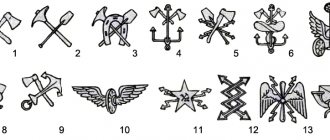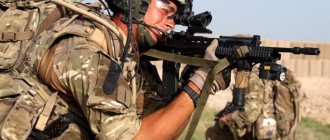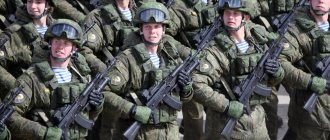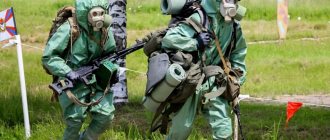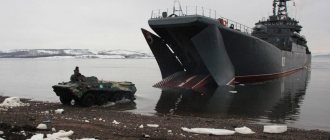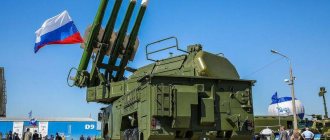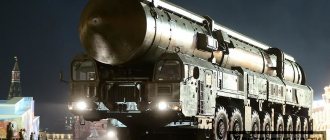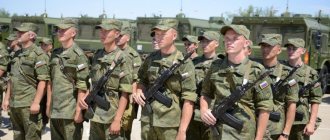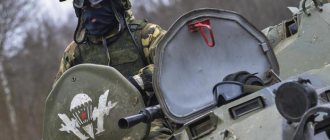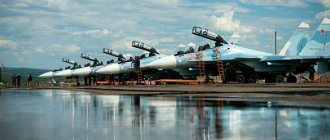The structure of the Armed Forces of the Russian Federation was developed in accordance with the political situation that has developed in the world after the collapse of the Soviet Union and in connection with newly emerging challenges and threats. It is designed to ensure the effectiveness of the combat use of armed forces while significantly simplifying the interaction of various types of armed forces and improving the command and control system.
A three-type structure has been adopted, including the following components:
- ground troops;
- aerospace forces;
- Navy.
There are two separate types of troops:
- strategic missile forces;
- airborne troops.
The armed forces also include:
- rear of the armed forces;
- Housing and Arrangement Service of the Ministry of Defense of the Russian Federation;
- railway troops;
- Main Military Medical Directorate;
- troops not included in the branches of the armed forces.
Ground troops
As the name suggests, ground forces are designed to conduct combat operations primarily on land. In the history of the Russian state, these troops have always played a vital and often decisive role in achieving victory over the enemy and protecting national interests.
The Ground Forces of the Russian Federation consist of the main branches of the military, special troops and logistics institutions. The main branches of the military are tank, motorized rifle, missile and artillery troops, air defense troops, reconnaissance formations and military units, radiation and chemical protection engineering troops, as well as communications troops.
Tank forces
Tank troops represent the main striking force of the ground forces. They have great firepower, high maneuverability and are better protected from weapons of mass destruction than other types of troops.
Tank troops are used primarily in conjunction with motorized rifle troops in the main axes and perform the following tasks:
- in defense - direct support of motorized rifle troops when repelling an enemy offensive and launching counterattacks and counterstrikes;
- in the offensive - delivering powerful cutting strikes to great depth, developing success, defeating the enemy in oncoming battles and battles.
Motorized rifle troops
Motorized rifle troops are the most massive branch of the military.
They work closely with tank forces and perform the following tasks:
- in defense - holding occupied areas, lines and positions, repelling enemy attacks and defeating his advancing groups;
- in an offensive (counter-offensive) - breaking through the enemy’s defenses, defeating groupings of his troops, capturing important areas, lines and objects, crossing water barriers, pursuing a retreating enemy;
- conducting oncoming battles and battles, operating as part of naval and tactical airborne assault forces.
Rocket Forces and Artillery
Rocket forces and artillery form the basis of the firepower of ground forces.
Formations, units and subunits of this type of troops are designed to perform the following main tasks:
- gaining and maintaining fire superiority over the enemy;
- defeat of its nuclear attack means, manpower, weapons, military and special equipment;
- disorganization of systems for command and control of troops and weapons, reconnaissance and electronic warfare;
- destruction of long-term defensive structures and other infrastructure;
- disruption of operational and military logistics;
- weakening and isolating the enemy's second echelons and reserves;
- destruction of enemy tanks and other armored vehicles that have penetrated into the depths of the defense;
- covering open flanks and joints;
- participation in the destruction of enemy air and sea landings;
- remote mining of terrain and objects;
- lighting support for night operations of troops;
- smoke, blinding enemy targets;
- distribution of propaganda materials, etc.
Ground Forces Air Defense Forces
This branch of the military is intended to cover troops and objects from the actions of enemy air attacks during combined-arms formations and formations of operations, regrouping and positioning on the spot.
They are responsible for the following main tasks:
- carrying out combat duty in air defense;
- conducting reconnaissance of enemy air and alerting covered troops;
- destruction of enemy air attack weapons in flight;
- participation in the conduct of missile defense in theaters of military operations.
Intelligence units and military units
Reconnaissance formations and military units belong to the special forces of the ground forces and are designed to perform a wide range of tasks in order to provide commanders (commanders) and headquarters with information about the enemy, the state of the terrain and weather in order to make the most rational decisions for an operation (battle) and prevent surprise in enemy actions .
In preparation for and during the conduct of combined arms operations (combat operations), they perform the following main tasks:
- revealing the enemy's plan, his immediate preparation for aggression and preventing the surprise of an attack;
- identifying the combat strength, position, grouping, condition and capabilities of the enemy troops (forces) and its command and control system;
- opening objects (targets) for destruction and determining their location (coordinates);
- opening elements of theater operational equipment, terrain engineering equipment and obstacle systems;
- establishing the degree of terrain passability, the state of communications, the nature of water barriers, the boundaries and sizes of areas of destruction, fires and floods, contamination zones, possible directions for overcoming and bypassing them;
- identification of new means of armed warfare and methods of conducting combat operations used by the enemy, as well as measures taken by him to comprehensively support the operation (combat);
- determination of the moral and psychological state of enemy troops and the local population, the economic state of the area of operation (combat operations), etc.
Corps of Engineers
Engineer troops are special troops designed to perform the most complex tasks of engineering support for combined arms operations (combat operations), requiring special training of personnel and the use of engineering weapons, as well as to inflict losses on the enemy through the use of engineer ammunition.
When preparing and conducting combined arms operations (combat operations), engineering troops perform the following main tasks:
- engineering reconnaissance of the enemy, terrain and objects;
- construction (arrangement) of fortifications (trenches, trenches and communication passages, shelters, dugouts, shelters, etc.) and arrangement of field structures (residential, economic, medical) for the deployment of troops;
- installation of engineering barriers, including the installation of minefields, blasting operations, installation of non-explosive barriers (anti-tank ditches, scarps, counter-scarps, gouges, etc.);
- demining of terrain and objects;
- preparation and maintenance of troop movement routes;
- equipment and maintenance of crossings on water barriers, including the construction of bridges;
- extraction and purification of water in the field, etc.
Radiation and chemical protection troops
Radiation, chemical and biological protection troops (RCBZ) are special troops designed to carry out a complex of the most complex measures aimed at reducing losses of formations and formations of ground forces and ensuring the fulfillment of combat missions assigned to them when operating in conditions of radioactive, chemical and biological contamination, and also to increase their survivability and protection from precision and other types of weapons.
Read: 1st Guards Motorized Rifle Division
RCBZ troops perform the following tasks:
- identification and assessment of the radiation, chemical and biological situation, the scale and consequences of destruction of radiation, chemical and biologically hazardous objects;
- ensuring the protection of compounds and parts from the damaging factors of weapons of mass destruction and radiation, chemical, biological contamination;
- reducing the visibility of troops and objects;
- liquidation of consequences of accidents (destructions) at radiation, chemically and biologically hazardous facilities;
- inflicting losses on the enemy using flamethrower and incendiary weapons.
Signal Corps
Signal troops are classified as mixed troops. They are designed to deploy a communications system and provide command and control of formations, formations and units of ground forces in peacetime and wartime. They are also tasked with operating systems and automation equipment at control points.
Purpose and composition of the Armed Forces of the Russian Federation
The Russian Armed Forces are an integral element of statehood, a military organization that forms the basis of the country's defense. They are intended to repel aggression directed against the Russian Federation, armed defense of the integrity and sovereignty of Russia. The Armed Forces of the Russian Federation can also be used to protect against unconstitutional actions within the state, illegal armed violence, and to carry out tasks in accordance with international treaties of the Russian Federation. In peacetime and wartime, the Armed Forces of the Russian Federation, in accordance with federal legislation, carry out the tasks assigned to them jointly with other troops, military formations and bodies.
The composition, strength, and equipment with the main types of weapons and military equipment are determined taking into account the tasks assigned to the Armed Forces of the Russian Federation, the geostrategic position of Russia, international treaties, as well as the emerging military-political and strategic situation in the world and the economic capabilities of the country. Currently, the Armed Forces of the Russian Federation are equipped with conventional and nuclear weapons, weapons and military equipment that allow them to reliably guard and defend Russia’s borders.
The leadership of the Armed Forces of the Russian Federation is exercised by the President of the Russian Federation - the Supreme Commander-in-Chief of the Armed Forces of the Russian Federation. Within the limits of his powers, he issues orders and directives that are mandatory for execution in the Armed Forces of the Russian Federation, other troops, military formations and bodies of the Russian Federation.
Exercising direct control of the Armed Forces of the Russian Federation, the President of Russia approves their structure and composition up to and including unification, as well as the staffing number of military personnel of the Armed Forces of the Russian Federation. The list of military positions filled by senior officers in the Armed Forces of the Russian Federation and other troops is also approved by the President of the Russian Federation. He also has the right to appoint military personnel to these positions and assign them senior officer ranks.
The President of the Russian Federation occupies an independent and extremely important place in the system of ensuring the security of the state and the armed protection of its citizens. His powers are aimed at ensuring coordinated interaction of all branches of government to protect the state sovereignty of Russia and strengthen the defense capability of the Armed Forces of the Russian Federation. He has a special responsibility to the people for the state of the Russian Armed Forces and their readiness to defend their state and their people.
The Armed Forces are managed by the Minister of Defense of the Russian Federation through the Ministry of Defense and the General Staff of the Armed Forces of the Russian Federation. being the main body of operational control of the Armed Forces of the Russian Federation.
The Ministry of Defense of the Russian Federation is a federal executive body that pursues state policy and carries out public administration in the field of defense, as well as coordinating the activities of federal ministries and other federal executive bodies of constituent entities of the Russian Federation on defense issues.
The General Staff of the Armed Forces of the Russian Federation is the central body of military command and the main body of operational control of the Armed Forces of the Russian Federation, coordinating the activities of other TROOPS, military formations and bodies to carry out tasks in the field of national defense.
The Ministry of Defense of Russia, in addition to the General Staff of the Armed Forces, includes services, main and central directorates, main commands of services, commands of branches of the Armed Forces of the Russian Federation, the Logistics Directorate of the Armed Forces, and other control bodies.
Organizationally, the Armed Forces of the Russian Federation consist of central military command bodies, associations, formations, military units, institutions and organizations, as well as military educational institutions that are included in the types and branches of the military, the Logistics of the Armed Forces and troops that are not included in the types and branches of the military. Armed Forces of the Russian Federation.
Military command and control bodies are designed to lead troops (forces) at various levels in both peacetime and wartime conditions. These include commands, headquarters, departments, departments and other permanently and temporarily created structures. To locate and operate control elements in combat conditions, control posts are deployed.
Associations are military formations that include several smaller formations or associations, as well as units and institutions. The associations include the army, flotilla, military district - operational-strategic territorial combined arms association and fleet - naval association.
A military district is an operational-strategic territorial combined arms association of military units, formations, educational institutions, military institutions of various types and branches of the Armed Forces of the Russian Federation.
The fleet is the highest operational-strategic formation of the Navy. District and fleet commanders direct their troops (forces) through the headquarters subordinate to them.
Formations are military formations consisting of several units or formations of a smaller composition, usually various branches of troops (forces), special troops (services), as well as support and service units (units). Formations include corps, divisions, brigades and other military formations equivalent to them.
A military unit is an organizationally independent combat and administrative-economic unit in all branches of the Armed Forces of the Russian Federation. Military units include all regiments, ships of ranks 1, 2 and 3, individual battalions (divisions, squadrons) and individual companies that are not part of battalions and regiments.
The institutions of the Ministry of Defense of the Russian Federation include such structures for supporting the life activities of the Armed Forces of the Russian Federation, such as military medical institutions, officers' houses, military museums, editorial offices of military publications, sanatoriums, rest homes, tourist centers, etc.
Military educational institutions include: military academies, military universities and institutes, higher and secondary military schools, military faculties at civilian universities, Suvorov and Nakhimov schools, training and retraining courses for officers.
Part of the Armed Forces of the Russian Federation may be part of the joint armed forces (JAF) or be under a unified command in accordance with international treaties of the Russian Federation (for example, as part of the UN peacekeeping forces or collective CIS peacekeeping forces in zones of local military conflicts).
Recruitment of the Armed Forces of the Russian Federation with personnel is carried out in accordance with the legislation of the Russian Federation: military personnel - by conscripting citizens of the Russian Federation for military service on an extraterritorial basis and by voluntarily enrolling citizens of the Russian Federation for military service; civilian personnel - by voluntarily entering work.
2
The Armed Forces of the Russian Federation include the branches of the Armed Forces of the Russian Federation: Ground Forces, Air Force and Navy. Each branch of the Armed Forces of the Russian Federation consists of branches of troops (forces); to comprehensively support the combat activities of the branches of the Armed Forces of the Russian Federation, they include special troops and logistics.
Ground forces are designed to repel enemy aggression in continental theaters of military operations, protect the territorial integrity and national interests of Russia, hold occupied territories, regions, borders and positions, defeat troop groups and capture enemy territory in cooperation with other branches and branches of the Armed Forces of the Russian Federation. They consist of military command bodies, combined arms armies, army corps, motorized rifle (tank), artillery and machine gun-artillery divisions (brigades), storage bases for weapons and equipment, storage bases for military property, district training centers, fortified areas, individual military units, institutions, enterprises and organizations.
The Ground Forces include: motorized rifle troops, tank troops, missile troops and artillery, air defense troops, which are branches of the military, as well as special troops (formations and units of reconnaissance, communications, electronic warfare, engineering, NBC protection, technical support), military units and logistics institutions, other units and organizations.
Motorized rifle troops are designed to conduct combat operations independently and jointly with other branches of the military, as well as special troops in conditions of the use of both conventional weapons and nuclear weapons. Motorized rifle formations and units are capable of marching over long distances, conducting maneuverable combat operations at any time of the year and day on various terrain, independently crossing water obstacles, capturing important lines and objects, and creating a stable defense in a short time. They can operate as part of air and sea landings.
Tank troops constitute the main striking force of the Ground Forces. They are designed to conduct combat operations primarily in the direction of the main attack. Possessing firepower, reliable protection, high mobility and maneuverability, tank forces are able to make full use of the results of nuclear and fire strikes and achieve the final goals of a battle and operation in a short time.
Rocket forces and artillery are the backbone of the Ground Forces' firepower. They are designed to inflict effective fire damage on the enemy. During combat operations, the Rocket Forces and artillery perform a variety of fire missions: suppression and destruction of enemy personnel, fire weapons and other types of military equipment; destruction of various defensive structures; prohibiting the enemy from maneuvering, conducting defensive work, or restoring destroyed objects.
The air defense troops of the Ground Forces are designed to cover troop groups and their rear facilities from enemy air strikes. They are capable, independently and in cooperation with the forces and means of the Air Force, of destroying aircraft and unmanned air attack weapons, combating enemy airborne assaults on flight routes and during their drop, carrying out radar reconnaissance and notifying troops of an air attack.
The engineering troops are called upon to ensure a high rate of attack, including the destruction of strong enemy strongholds, to create insurmountable defensive lines in a short time, and to help protect people and equipment from all types of destruction. In peacetime, they perform a number of specific tasks, which in their significance and complexity are equal to combat ones: first of all, demining the area, neutralizing explosive objects, etc.
Formations and units of other special forces of the Ground Forces - reconnaissance, communications, electronic warfare, engineering, chemical warfare protection, technical support, automobile and rear security - perform tasks according to their intended purpose.
The Air Force of the Russian Federation is intended to protect administrative-political, military-industrial centers, communication centers, forces and means of higher military and government administration, important elements of the national economic infrastructure of Russia, troop groups from enemy strikes from the air and from space, destruction of objects and troops the enemy using conventional and nuclear weapons, as well as to support combat operations of the Ground Forces and the Navy. They play a decisive role in gaining dominance in the air (aerospace).
Organizationally, the Air Force consists of: military command and control bodies; long-range, military transport, front-line (operational-tactical), army aviation; anti-aircraft missile and radio technical troops; special troops (units and subunits of electronic warfare, chemical warfare protection, communications and radio technical support, surveying, airfield engineering, meteorological, etc.); military units and logistics institutions; other military units, institutions, enterprises and organizations.
The Navy is designed to ensure the protection of the interests of the Russian Federation and its allies in the oceans by military means, repelling aggression from sea and ocean directions, defeating enemy naval forces in strategic ocean areas and maritime zones, defeating its military-economic potential, and also to solve other problems in the field of national defense in cooperation with other types and branches of the Armed Forces of the Russian Federation.
The priority task of the fleet is to prevent the outbreak of wars and armed conflicts, and in the event of aggression, to repulse it, cover the country’s facilities, forces and troops from ocean and sea directions, defeat the enemy, create conditions for preventing military actions at the earliest possible stage and concluding peace in conditions that meet the interests of Russia. In addition, the task of the Navy is to conduct peacekeeping operations by decision of the UN Security Council or in accordance with the international allied obligations of the Russian Federation.
To solve the priority task of preventing the outbreak of war, the naval strategic nuclear forces, which have certain advantages in comparison with the Strategic Missile Forces and strategic aviation, have been retained as part of the country's strategic nuclear forces. With such basing, nuclear weapons are removed outside the territory of one’s own state, which reduces the threat to civilians and, most importantly, submarines are the least vulnerable in comparison with other types of nuclear weapons.
In addition to naval strategic nuclear forces, the Navy has general-purpose forces. In the event of aggression, they must repel the enemy’s attacks, defeat the strike groups of his fleet and prevent him from conducting large-scale and deep naval operations, as well as, in cooperation with other branches of the Armed Forces of the Russian Federation, ensure the creation of the necessary conditions for the effective conduct of defensive operations in continental theaters of military operations .
The basis of the general purpose forces of the Navy are submarine forces, which form the core of the fleet's strike potential, as the most versatile, mobile and powerful type of force, capable of effectively fighting any naval enemy. Their main element is nuclear submarines.
The intraspecific structure of the Navy includes: submarine forces, surface forces, naval aviation, air defense troops, ground and coastal forces, which are the branches of the forces (troops) of the Navy, as well as support units and units (reconnaissance, naval engineering, NBC protection , communications, radio engineering, electronic warfare, technical support, search and rescue, hydrographic service), rear units and organizations, other units and organizations.
Organizationally, the Navy consists of four fleets: the Northern, Pacific, Baltic and Black Sea, as well as the Caspian Flotilla and the Novorossiysk Naval Region. The indicated associations bring together the corresponding flotillas, squadrons, naval bases, divisions, brigades and regiments.
The basis of the Northern and Pacific fleets are strategic missile submarines and multi-purpose nuclear submarines, aircraft carriers, landing and multi-purpose surface ships, naval missile-carrying and anti-submarine aircraft.
The basis of the Baltic, Black Sea fleets and the Caspian flotilla are multi-purpose surface ships, mine-sweeping ships and boats, diesel submarines, coastal missile and artillery troops and attack aircraft.
Currently, the Navy is armed with strategic missile submarines, multi-purpose nuclear and diesel submarines, surface combat ships of the main classes, coastal ships and boats, and naval aviation aircraft and helicopters. The special geographical location of certain regions of the Russian Federation presupposes the presence in the fleets of groups of coastal troops, forces and air defense systems intended for the defense of these territories.
3
The Armed Forces of the Russian Federation include branches of the Armed Forces of the Russian Federation - Strategic Missile Forces, Space Forces, Airborne Forces, as well as troops that are not included in the branches and branches of troops.
Associations, formations and units of the armed forces of the Armed Forces of the Russian Federation carry out assigned tasks in close cooperation with each other and with land, sea and aviation groups of troops (forces), using their inherent means of armed struggle, forms and methods of conducting military operations. Each branch of the Armed Forces consists of formations (except for the Airborne Forces), formations and units designed to solve certain operational-strategic, operational and tactical tasks. To comprehensively ensure the combat activities of the armed forces of the Armed Forces, they include special troops and logistics personnel.
Strategic Missile Forces (Strategic Missile Forces) - designed for nuclear deterrence of a potential enemy and the destruction of objects of its military and economic potential by nuclear missile strikes during the war. The Strategic Missile Forces are equipped with intercontinental and medium-range missiles, the latest automated control systems, are constantly on duty and are always ready to retaliate against the aggressor.
Organizationally, the Strategic Missile Forces consist of missile armies and divisions, training grounds, military educational institutions, enterprises and institutions.
The basis of the armament of the Strategic Missile Forces are stationary and mobile (ground and railway) missile systems.
The Space Force is designed to detect the start of a missile attack on the Russian Federation and its allies; combating enemy ballistic missiles; maintaining orbital constellations of military and dual-use spacecraft in the established composition and ensuring the use of spacecraft for their intended purpose; space control; ensuring the implementation of the Russian Federal Space Program, international cooperation programs and commercial space programs.
The Space Forces include formations and military units of missile attack warning systems, missile defense and space control systems; State test cosmodromes “Baikonur”, “Plesetsk” and “Svobodny”; Main Test Center for Testing and Control of Spacecraft named after GS. Titova; military educational institutions.
Airborne troops (Airborne Forces) are a highly mobile branch of the Armed Forces of the Russian Federation, designed to reach the enemy by air and carry out tasks in his rear.
Being the reserve of the Supreme Commander-in-Chief, the Airborne Forces are capable of solving operational and tactical combat missions both in large-scale wars and in local conflicts independently or as part of Ground Forces groupings. The Airborne Forces are a branch of the military, 95% consisting of units of constant readiness. Airborne troops or their individual units can be used as parachute landings behind enemy lines.
Organizationally, the Airborne Forces consist of military command bodies, airborne and air assault formations and units, as well as special troops (reconnaissance, communications, engineering, aviation, technical support), a training center, logistics units and organizations, and other units and organizations.
To ensure the combat activities of the Armed Forces of the Russian Federation and solve their inherent tasks, troops not included in the types and branches of the military are divided into: reconnaissance, engineering, radiation, chemical and biological protection, communications, electronic warfare, technical and logistics support.
The rear of the Armed Forces of the Russian Federation is intended for logistics and logistics services technical support for troops (forces). Acts as a link between the country's economy and troops (forces).
In the interests of all branches of the Armed Forces of the Russian Federation (branches of troops, special troops), it performs the following main tasks: receiving supplies of material resources and logistics equipment from the country's economic complex, storing and providing them to troops (forces); planning and organizing, together with transport ministries and departments, the preparation, operation, technical cover and restoration of communication routes and vehicles; supply of all types of material resources to troops (forces); ensuring military transportation, basing of aviation and naval forces; technical support for logistics services; medical, veterinary and sanitary, trade and household, housing and maintenance support (in wartime), etc.
The Logistics Service of the Armed Forces of the Russian Federation includes: central military command and control bodies of the Armed Forces of the Russian Federation and other military command and control bodies; special troops (automobile, road, railway, pipeline); formations, military units and units of material, transport, engineering, airfield, airfield technical support and rear security; medical units, military units and institutions; organizations (bodies) of logistics services (bases, warehouses, factories, workshops, detachments, trains, laboratories, etc.); military units and combat support units (engineering, radiological and chemical warfare defense of the rear, rear communications). Organizational strength and means
The rear of the Armed Forces of the Russian Federation are part of all associations, formations, military units and subunits and are directly subordinate to the central authorities.
In the logistics system of the Armed Forces of the Russian Federation, it is customary to distinguish the following links: according to the scale and nature of the tasks performed - strategic, operational and military logistics; by affiliation - rear of the Center, front, district, naval, army, corps, flotillas, squadrons, divisional, brigade, regimental, battalion and rear of divisions, etc.
Aerospace Forces
This branch of the armed forces was formed on August 1, 2015.
It includes the following types of troops:
- air Force;
- space forces;
- air defense troops.
Air Force
The Air Force (AF) is designed to:
- repelling aggression in the air and protecting command posts of the highest echelons of state and military administration, administrative and political centers, industrial and economic regions, the most important economic and infrastructure facilities of the country and groupings of troops (forces) from air strikes;
- defeating enemy targets and troops using both conventional and nuclear weapons;
- aviation support for combat operations of troops (forces) of other types and branches of troops.
Space Force
Space forces solve a wide range of tasks, the main of which are:
- monitoring space objects and identifying threats to Russia in and from space, and, if necessary, countering such threats;
- providing senior management levels with reliable information about the detection of ballistic missile launches and warning about a missile attack;
- launching spacecraft into orbit, controlling military and dual-purpose (military and civil) satellite systems in flight and using individual of them in the interests of providing the troops (forces) of the Russian Federation with the necessary information;
- maintaining the established composition and readiness for use of military and dual-use satellite systems, means of launching and controlling them, and a number of other tasks.
Air defense troops
The Air Defense and Missile Defense Forces (AD-ABM) ensure the protection of the aerospace space of the Russian Federation.
They solve a wide range of problems, the main of which are:
- repelling aggression in the aerospace sphere and protecting command posts of the highest echelons of state and military command, groupings of troops (forces), administrative and political centers, industrial and economic regions, the most important economic facilities and infrastructure of the country from attacks by enemy aerospace attacks;
- defeating the warheads of ballistic missiles of a potential enemy attacking important government facilities.
Certain types of troops
Individual branches include missile and airborne structures.
Strategic Missile Forces (RVSN)
The Strategic Missile Forces are designed to deter enemy aggression and defeat them as part of nuclear forces. They can act independently with the help of nuclear missile strikes.
Rocket technology began to be actively researched back in the 1930s. The silo-based projectile was first used in 1960. After the collapse of the Soviet Union, the Strategic Missile Forces became part of the Russian Armed Forces; after another 5 years they were merged with space structures. Only in 2001 they were separated into a separate type of aircraft.
Strategic Missile Forces
Airborne troops (VDV)
Airborne paratroopers are part of the reserve of the Supreme High Command. Their task is to reach the enemy by air, destroy objects, and disrupt enemy communications.
In peacetime, the Airborne Forces maintain combat and mobilization activities at the proper level. Their structure includes the following divisions:
- airborne;
- assault;
- mountain.
Often, troops are used as quick reaction forces and delivered to the battlefield using helicopters and airplanes. Thus, each branch of the military has specific tasks. All units are unique and at the same time universal.
Navy
The Navy (VMF) is a branch of the Armed Forces of the Russian Federation (RF Armed Forces). It is intended for the armed protection of Russian interests and for conducting combat operations in the sea and ocean theaters of war. The Navy is capable of delivering nuclear strikes on enemy ground targets, destroying enemy fleet groups at sea and bases, disrupting the enemy’s ocean and sea communications and protecting its maritime transport, assisting ground forces in operations in continental theaters of war, landing amphibious assault forces, and participating in repelling landing forces. enemy and perform other tasks.
Currently, the Navy is entrusted with the following tasks:
- deterrence from the use of military force or the threat of its use against the Russian Federation;
- protection by military methods of the sovereignty of the Russian Federation, extending beyond its land territory to internal sea waters and the territorial sea, sovereign rights in the exclusive economic zone and on the continental shelf, as well as freedom of the high seas;
- creation and maintenance of conditions to ensure the safety of the maritime economic activities of the Russian Federation in the World Ocean;
- ensuring the naval presence of the Russian Federation in the World Ocean - demonstration of the flag and military force, visits of ships and naval vessels;
- ensuring participation in military, peacekeeping and humanitarian actions carried out by the world community that meet the interests of the Russian Federation.
The Navy includes the following components:
- surface forces;
- submarine forces;
- naval aviation;
- coastal troops (coastal missile and artillery troops and marines).
The structure of the Armed Forces of the Russian Federation includes the following two separate branches of troops.
Strategic Missile Forces
The Strategic Missile Forces (RVSN) in the USSR were classified as a branch of the armed forces. Now their status has been reduced to a branch of the military, and a new term has also appeared - “strategic nuclear forces” (SNF). The strategic nuclear forces include the strategic missile forces themselves, also called ground-based strategic nuclear forces, aviation strategic nuclear forces (ASNF) and naval strategic nuclear forces (NSNF).
Strategic nuclear forces are equipped with long-range ballistic missiles and are designed to carry out strategic missions by delivering nuclear missile strikes.
Airborne troops
Airborne troops are a branch of troops designed for combat operations behind enemy lines. Units of these troops are parachuted from airplanes or helicopters or delivered by air behind enemy lines to airfields captured by paratroopers. Airborne troops are capable of quickly reaching remote areas, delivering surprise attacks on the enemy, quickly capturing important areas deep behind enemy lines, and disrupting the system of state and military control.
History of the Russian Army
On July 14, 1990, the first Russian military department appeared. It was called the “State Committee of the RSFSR for Support and Interaction with the Ministry of Defense and the KGB of the USSR.” After the August putsch in Moscow, the Ministry of Defense of the RSFSR was formed for a short time on the basis of a committee.
After the collapse of the USSR, the United Armed Forces of the CIS countries were formed, but this was a temporary measure: on May 7, 1992, the first Russian President Boris Yeltsin signed a decree on the creation of the Armed Forces of the Russian Federation.
Initially, the RF Armed Forces included all military units located on the territory of the country, as well as troops that were under Russian jurisdiction. Then their number was 2.88 million people. Almost immediately the question of reforming the armed forces arose.
The 90s were a difficult period for the Russian army. Chronic underfunding led to the fact that the best personnel left it, the purchase of new types of weapons practically ceased, many military factories were closed, and promising projects were stopped. Almost immediately after the creation of the Russian armed forces, plans appeared to completely transfer them to a contract basis, but lack of funding for a long time did not allow moving in this direction.
In 1995, the first Chechen campaign began, which demonstrated the catastrophic situation of the Russian army. The troops were understaffed, and the fighting showed serious shortcomings in their management.
In the second Chechen campaign (1999–2006), permanent readiness units, as well as airborne units, took part. In 2003, the share of contract soldiers in Chechnya reached 35%.
Back in the 90s, it was decided to divide all units and formations of the RF Armed Forces into four categories:
- permanent readiness units, staffed by 95-100% of wartime staff;
- reduced-strength units (about 70%);
- storage bases for military equipment and weapons (5-10%);
- cropped units (about 5%).
At the beginning of the 2000s, this reform was continued. It was decided to completely transfer the permanent readiness units to a contract basis, and recruit the remaining units on a fixed-term basis.
The first unit that was completely transferred to a contract basis was one of the regiments of the Pskov Airborne Division. In 2005, a reform of military management began: it was planned to create three territorial commands, under whose subordination all types and branches of the armed forces in a given territory would fall. This reform was actively promoted by Defense Minister Serdyukov, who was appointed to the post in 2007. In addition, back in 2006, a state rearmament program until 2020 was adopted.
In 2008, the Russian Armed Forces took part in the conflict in South Ossetia. He revealed a large number of shortcomings and problems of the modern Russian army. The most serious of them were low troop mobility and poor controllability. After the end of the conflict, the start of military reform was announced, which was supposed to significantly increase the mobility of the Armed Forces units and increase the coordination of their joint actions. The result of the reform was a reduction in the number of military districts (four instead of six), a simplification of the ground forces command and control system, and a significant increase in the army budget.
All this made it possible to speed up the entry of new military equipment into the troops, attract a larger number of contract professionals, and increase the intensity of combat training of units.
During the same period, regiments and divisions began to be reorganized into brigades. True, in 2013 the reverse process began: regiments and divisions began to form again.
In 2014, the Russian army played a key role in the return of Crimea. In September 2022, the operation of the Russian Armed Forces in Syria began, which continues to this day.
Military-administrative division of the Russian Federation
In accordance with Presidential Decree No. 1144 “On the military-administrative division of the Russian Federation” signed on September 20, 2010, all six existing military districts were abolished. The following four enlarged military districts were newly formed:
- The Western Military District includes the former Moscow and Leningrad military districts;
- The Central Military District includes the former Volga-Ural Military District and part of the Siberian Military District;
- The Eastern Military District includes part of the Siberian Military District and the former Far Eastern Military District;
- The Southern Military District was formed on the basis of the former North Caucasus Military District.
In wartime, on the basis of new military districts, joint strategic commands (USC) will be created, which will exercise operational leadership of diverse forces and means - ground forces, navies, and air forces.

